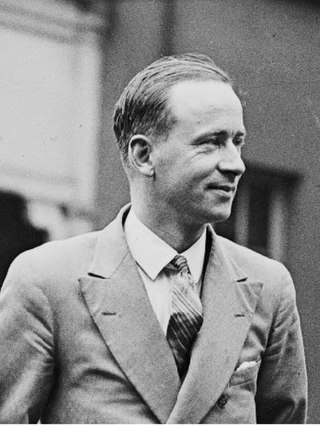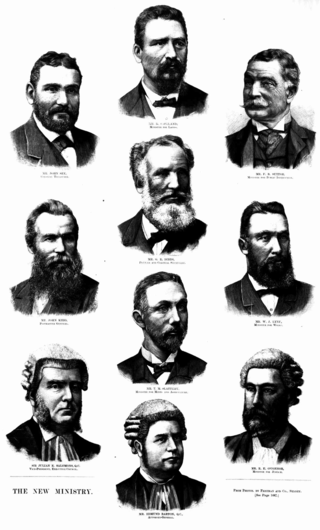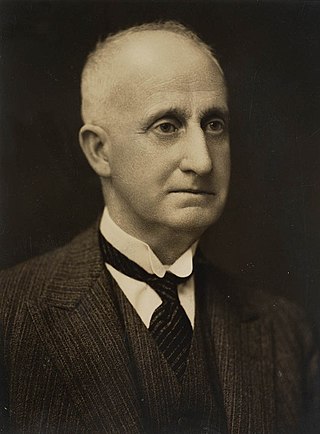History
The NSWGR built its entire route network to standard gauge. Its first line, also the first railway of New South Wales, was the railway line from Sydney to Parramatta (today: Granville railway station) completed in 1855.
The agency was managed by a range of different commission structures between 1857 and 1932, which reported to either the Minister for Public Works or the Minister for Transport.
The inaugural Chief Commissioner was Ben Martindale [1] and, following the enactment of the Government Railway Act, 1858 (NSW) he became Commissioner of Railways. John Rae succeeded Martindale in 1861, [2] and in 1877 Charles Goodchap was appointed Commissioner. The Government Railway Act, 1888 (NSW) set up a corporate body of three railway commissioners to manage the railways and remove them from political influence, resulting in the resignation of Goodchap. [3]
This Board of Railway Commissioners of New South Wales was in place from 22 October 1888 to 4 April 1907, and was replaced by a sole Chief Commissioner of Railways and Tramways until 22 March 1932, when a panel arrangement was restored for a period of nine months, with the Transport Commissioners of New South Wales. On 29 December 1932, the Department of Railways New South Wales was established and Thomas Joseph Hartigan was appointed Commissioner for Railways replacing the functions of the Chief Transport Commissioner. [4] The Department of Railways New South Wales become the official name of the railway and was used on most documentation (drawings & other paperwork), the NSWGR title was still used periodically on public documentation such as advertising and timetables. This continued until the creation of the Public Transport Commission on 20 October 1972. The last Commissioner for Railways was Neil McCusker.
Executives
Chief Commissioner for Railways and Tramways
Chief Transport Commissioner

The state of New South Wales is divided into three divisions: the Eastern Division, the Central Division, and the Western Division. These were established for the purposes of the management of the lease of Crown land to private persons. The Western Division includes Broken Hill, Bourke, Cobar, Cockburn, Walgett, Wentworth as well as the western land boards of Forbes, Griffith, Rankins Springs, West Wyalong, White Cliffs, Wyalong, Conargo, Hay and Parkes.

John Fletcher Hargrave was a British-born Australian politician and judge.

James Robinson Love (1836–1914) was an Australian merchant and founder of J. R. Love & Co Ltd and Kinkara Tea.

Major Clarence Edward Martin was an Australian politician and a member of the New South Wales Legislative Assembly from 1930 until 1932 and from 1939 until his death in 1953. He was variously a member of the Australian Labor Party (NSW), the Industrial Labor Party and the Labor Party (ALP). He was the Attorney General of New South Wales from 1941 until 1953 and also held the position of Minister for Transport for six months prior to his death.

The third Dibbs ministry, the 27th ministry of the Colony of New South Wales, was led by Sir George Dibbs, leader of the Protectionist Party, following the 1891 New South Wales election, which saw the Labour Party win seats in the New South Wales Legislative Assembly and the balance of power. With no party having a majority, Sir Henry Parkes held on as Premier until October 1891 when he lost a vote in the Legislative Assembly, causing Parkes to resign as Premier and leader of the Free Trade Party. Dibbs formed the ministry on 23 October 1891, with Labour support, and comprised 10 ministers.

The Storey ministry was the 37th ministry of the New South Wales Government, and was led by the 20th Premier, John Storey.

Thomas Woore was a Royal Navy officer, grazier, railways leader and surveyor. Woore was born in Derry, County Londonderry, Ireland and died in Double Bay, Sydney, Australia.

Richard Thomas Ball was a politician and engineer in New South Wales, Australia.
The Department of Railways New South Wales was the agency of the Government of New South Wales that administered rail transport in New South Wales, Australia between 1932 and 1972.
The Agent-General for New South Wales is the representative of the State of New South Wales in the United Kingdom who is responsible for the promotion of New South Wales' trade and economic interests in the United Kingdom, Europe and Israel. The holder is a state government public servant, as part of the Investment NSW agency, and also concurrently serves as New South Wales' Senior Trade and Investment Commissioner for Europe and Israel.
Frederick Augustus Cooper was an Australian politician who was a Member of both the New South Wales Legislative Assembly, and the Queensland Legislative Assembly.

Walter Edmunds was an Australian judge and politician.
Charles Kemp was an English-born Australian politician.

Sir John Beverley Peden was an Australian jurist and politician. Born in Randwick to farmer Magnus Jackson Peden, a mayor of Randwick, and Elizabeth Neathway Brown, he attended public school at Bega before studying at Sydney Grammar School and the University of Sydney, where he received a Bachelor of Arts in 1892 and a Bachelor of Laws in 1898. He was an assistant lecturer in Latin at the university from 1896 to 1898, when he was called to the bar. He lectured in law from 1903 and became a professor and faculty dean in 1910. Appointed to the New South Wales Legislative Council as a Nationalist in 1917, from 1929 to 1946 he was president of the council; he was both the last president appointed directly by the governor, and the first elected by his fellow councillors. Peden died in Paddington in 1946.

Solicitor General for New South Wales, known informally as the Solicitor General, is one of the Law Officers of the Crown, and the deputy of the Attorney General. They can exercise the powers of the Attorney General in the Attorney General's absence. The Solicitor General acts alongside the Crown Advocate, and Crown Solicitor, and serves as one of the legal and constitutional advisers of the Crown and its government in the Australian state of New South Wales.

Charles Gilbert Heydon was an Australian politician and judge.
A by-election was held for the New South Wales Legislative Assembly electorate of the Clarence on 23 July 1863 because Clark Irving had been absent for an entire session without leave, having travelled to England seeking the foundation of a new Anglican Diocese of Grafton & Armidale.
A by-election was held for the New South Wales Legislative Assembly electorate of Orange on 4 March 1879. It was triggered because the Elections and Qualifications Committee held that Edward Combes position of Executive Commissioner for New South Wales at the Paris International Exhibition was an office of profit under the crown and his seat was declared vacant.
A by-election was held for the New South Wales Legislative Assembly electorate of South Sydney on 4 June 1887 because Bernhard Wise was appointed Attorney General in the fourth Parkes ministry. Such ministerial by-elections were usually uncontested. Most of the ministry was not required to face a by-election as they had been appointed prior to the general election in February 1887. William Foster had been the Attorney General however he resigned on the ground that he had been promised an appointment to the Supreme Court and Henry Stephen had been appointed instead.













